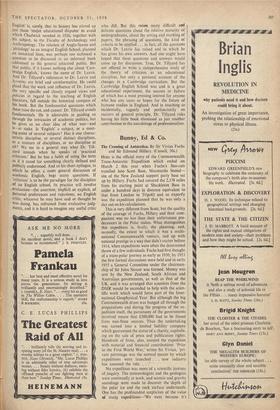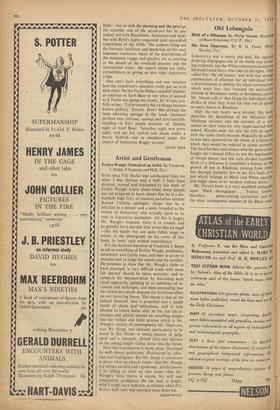Bunny, Ed & Co.
The Crossing of Antarctica. By Sir Vivian Fuchs and Sir Edmund Hillary. (Cassell, 30s.)
HERE is the official story of the Commonwealth Trans-Antarctic Expedition which ended on March 2 this year when Fuchs's Sno-cats trundled into Scott Base, Macmurdo Sound— site of the New Zealand support party base set up by Hillary. Fuchs had covered the 2,158 miles from his starting point at Shackleton Base in under a hundred days (a distance equivalent to that from London to Tripoli) and so expertly was the expedition planned that he was only a day out on his calculations. This is very different from Scott; but the quality of the courage of Fuchs, Hillary and their com- panions was no less than their unfortunate pre- decessors in the Polar stakes. What distinguishes this expedition is, firstly, the planning, and, secondly, the extent to which it was a multi- national Commonwealth venture, tied up with national prestige in a way that didn't matter before 1914, when expeditions were often the determined throw of a few individuals. Fuchs had first thought of a trans-polar journey as early as 1950; by 1953 the first formal discussions were held and in early 1955 a General Committee under the chairman- ship of Sir John Slessor was formed. Money was sent by the New Zealand, South African and Australian governments, as well as that of the UK, and it was arranged that scientists from the DSIR would be seconded to help with the scien- tific work which would form part of the Inter- national Geophysical Year. But although the big Commonwealth drum was banged all through the preparations and during the progress of the ex- pedition itself, the parsimony of the governments involved meant that £300,000 had to be found from non-State sources. Thus the undertaking was turned into a limited liability company which guaranteed the status of a charity, capitalis- ing on the sale of press and publication rights. Hundreds of firms, also, assisted the expedition with material and financial contributions. 'Prior to the First World War,' writes Sir Vivian, 'pri- vate patronage was the normal means by which expeditions were launched . . . now industry has assumed the role. . .
No expedition was more of a scientific journey of inquiry. The meteorologists and the geologists were continually at work, and seismic and gravity soundings were made to discover the depth of the polar ice and the rock surface underneath. One has the profoundest scepticism of the value of many expeditions—'We went because it's there'—but as with the planning and the prestige, the scientific side of the adventure 'has its pre- cedent, not with Shackleton, Amundsen and Scott, but with Byrd's highly organised (and successful) expeditions of the 1930s. The authors bring out the fantastic loneliness and desolation of this vast, unknown continent; many of the descriptions of the mountain ranges and glaciers are as exciting as the details of the overland journey and the surmounted crises : the superb plates are really extraordinary in giving an idea what Antarctica is like.
One can't have everything and one wonders how the expedition's members really got on with each other. On the Fuchs-Hillary standoff whether to continue to Scott Base or not when it seemed as if Fuchs was going too slowly, Sir Vivian tact- fully writes : 'Unfortunately this exchange became known publicly.' Exactly. How? But perhaps the most alarming passage in the book—journeys perilous over crevasse, sastrugi and neve notwith- standing—is Ed's jaunty account of Satiddy night at Scott Base : 'Saturday night was party night, and the but rocked and shook under a hearty Scottish reel or shuddered under the impact of boisterous Rugby scrums.'
DAVID REES



































 Previous page
Previous page